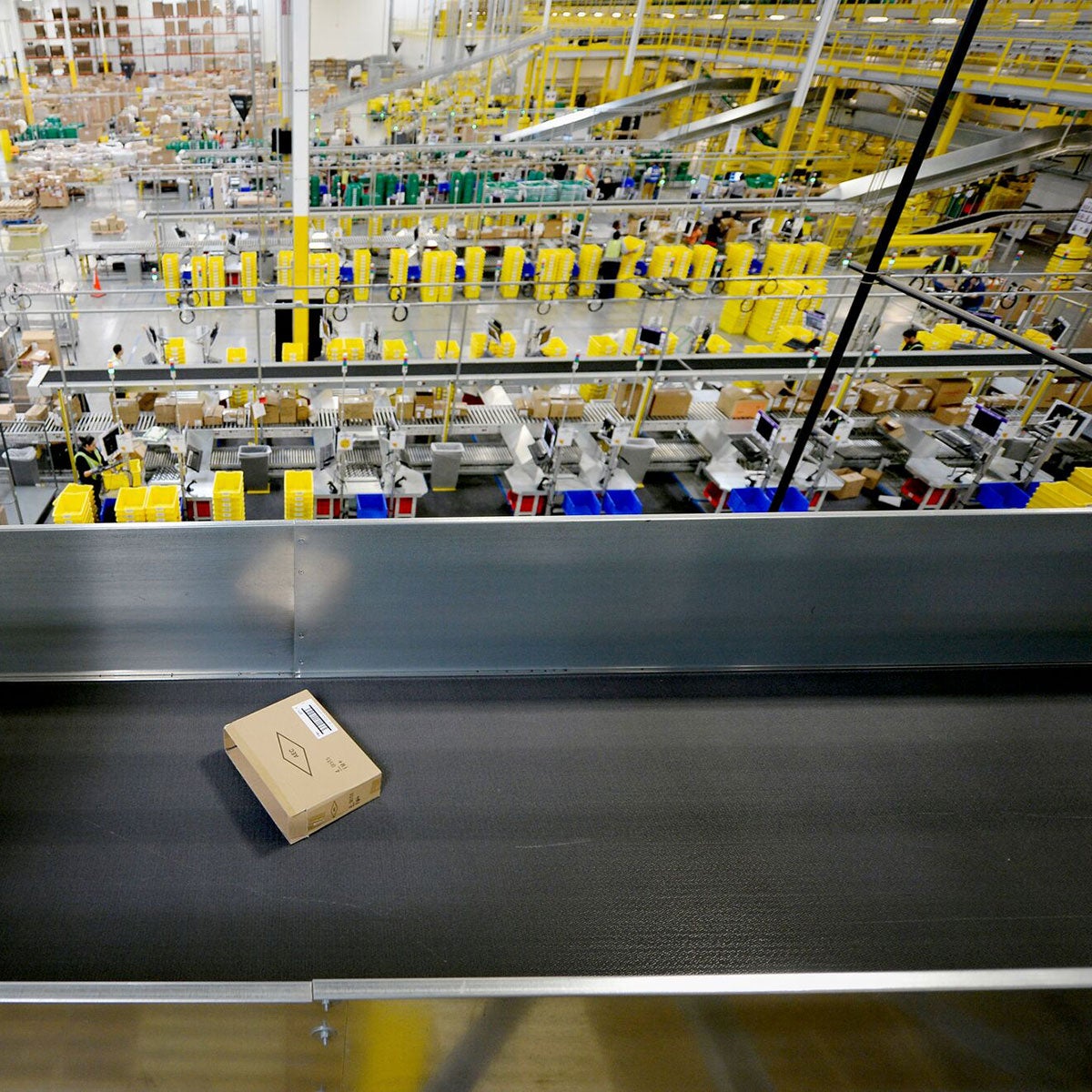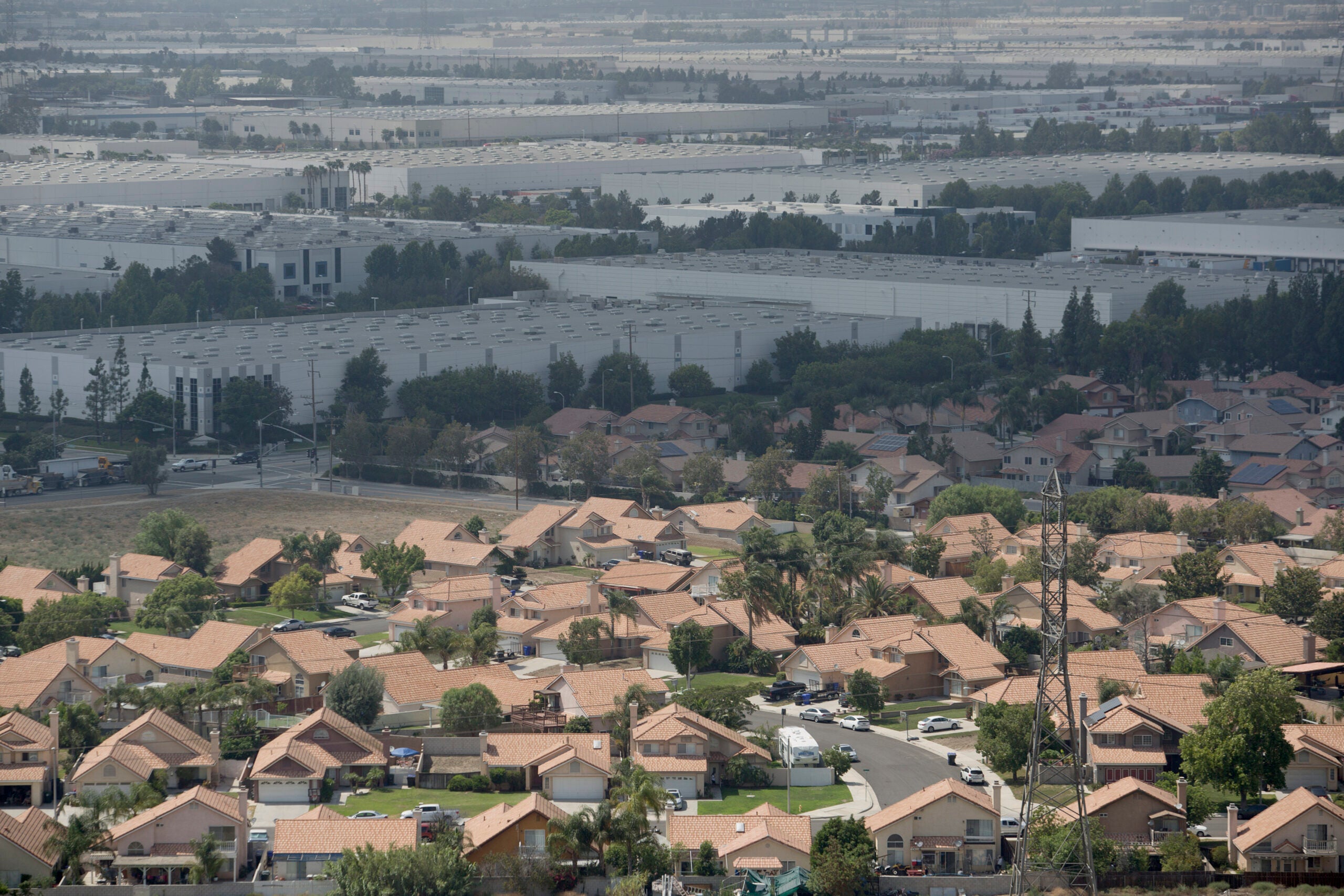It’s Working: Warehouses in Southern California Are Cleaning Up Their Act
Warehouse Rule brings zero emissions equipment to California, proving the strength of the model.
As you may have noticed, e-commerce continues to grow like crazy — along with the massive warehouse and transportation infrastructure built to handle and move all those packages. So in 2021, Southern California did something smart: the South Coast Air Quality Management District (SCAQMD) enacted an innovative, creatively structured rule designed to clean up pollution from California’s huge and growing complex of warehouses.
The walls of a mega warehouse don’t pollute, of course — it’s just metal and other building materials. But the fleets of diesel trucks and other equipment that carry goods to and from warehouses and move them around the building and its grounds pollute the communities around them — a lot. This generation of pollution around a warehouse makes it what’s called an “indirect source” of pollution.

Trucks line up outside the Amazon ONT 2 and 5 facilities in San Bernardino. (Image courtesy of Anthony Victoria-Midence / CCAEJ)
The new regulation, called the Warehouse Indirect Source Rule, was designed to address the massive and growing pollution burden — ozone, nitrogen oxides, and particulates — indirectly generated by these warehouses. These pollutants create smog and increase people’s risk of an awful assortment of serious health problems, including damage to our airways, heart attacks, cancer, and even premature death.
A Pollution Boom We Can See from Space
Underregulated warehouses are a massive and growing problem. Fueled by increasing import traffic through the ports of Los Angeles and Long Beach, Southern California’s warehouse complex has been growing at the rate of about 175 million square feet per decade since the 1980s, when imports from China started to boom. The number of industrial warehouses in San Bernardino and Riverside counties has multiplied from 162 in 1975 to 4,299 in 2021. This massive transformation means you can literally see this logistics hub from space.
In just the Inland Empire (San Bernardino, Riverside and surrounding communities) alone, warehouses now cover nearly 37 contiguous square miles. Put another way, that’s enough warehouses to blanket three quarters of the city of San Francisco!
Diesel truck traffic serving these warehouses contributed to Southern California receiving a failing grade in the American Lung Association’s annual State of the Air report as well as failing a number of federal clean air standards. An SCAQMD analysis found that traffic to and from these warehouses produce nearly the same amount of nitrogen oxide emissions as all of the factories, refineries, and other buildings that emit pollutants in the entire region combined. And of course, all those diesel trucks and other equipment that serve warehouses also belch climate-altering carbon dioxide into the air.
Not surprisingly, neighborhoods near these warehouses feel the worst effects of all this pollution. These communities are disproportionately low-income, and nearly 70% of warehouse-adjacent communities in the SCAQMD are made up of people of color.

(Hannah Rothstein for Earthjustice)
So SCAQMD, with the strong support of Earthjustice and other environmental and community groups like People’s Collective for Environmental Justice, East Yard Communities for Environmental Justice, Sierra Club, and the Center for Community Action and Environmental Justice, decided to take action. After carefully listening to all the stakeholders, including representatives of the warehousing industry, it created a new program called the Warehouse Actions and Investments to Reduce Emissions program, or WAIRE.
No Good Clean Air Deed Goes Unpunished
In light of the need to clean up pollution, the trucking industry filed a lawsuit challenging the South Coast warehouse rule. The airline industry also joined in on the lawsuit claiming the warehouse rule could not clean up its pollution from warehouses associated with air cargo. At the crux of the lawsuit are claims that federal law disallows local and state entities from protecting communities from deadly pollution. But this legal fight is not going well for polluters.
In the last couple of months, this lawsuit seeking to derail clean air progress has been dealt major blows. First, despite trucking industry protestations, then Environmental Protection Agency (EPA) Region 9 gave the warehouse rule a draft stamp of approval that it met Clean Air Act requirements. Second ‐ and perhaps the biggest blow to date — a federal district court judge on Friday rejected their claims that several federal laws and the Constitution disallowed the SCAQMD to protect us from harmful warehouse pollution. This is also yet another confirmation of the agency’s legal authority to adopt indirect source rules for ports and rail yards.
We suspect that their legal attacks will continue, but these two actions — along with the great progress in rule implementation — show that industry’s efforts to derail the regulation were more bark and less bite.
A Blueprint for Electrifying Warehouses Around the Country
The warehouse rule provides lots of flexibility to industry. Instead of dictating to warehouse operators exactly what they must do, WAIRE gives them a menu of choices to pick from, depending on their circumstances and the details of their particular operation. Choices include acquiring zero-emissions trucks, installing charging infrastructure for zero-emissions trucks, installing solar panels, or taking actions to mitigate community health harms from truck emissions (such as installing air filtration systems in schools, hospitals, and other community gathering spots). For each action they take, they earn points toward a required total.

Trucks haul shipping containers at the Port of Los Angeles, the nation’s busiest port, to warehouses throughout the region. Their emissions create diesel death zones along freight lines and freeways throughout the state. (Getty Images)
Importantly, facilities earn points not just for acquiring pollution-free equipment but for actually using it, via measures like the number of trips to and from the warehouse by zero-emission vehicles. The menu of choices gives operators over 30 different options, and they can also create a custom WAIRE plan, with approval from SCAQMD. These point requirements are being phased in so as to avoid placing a sudden and unreasonable burden on the affected businesses, starting with the largest warehouses first.
What kind of actions? The WAIRE plan set up by Maersk Warehousing and Distribution Services for its facility in South Gate provides a good example. Maersk is electrifying its fleet of drayage trucks that service the South Gate warehouse and another SoCal facility. It already has 38 battery electric trucks and is in the process of increasing that number to 396 by 2026. The company has nearly completed installation of charging stations with a total of 96 charging ports to power those trucks. That’s nearly 400 trucks that won’t be spewing cancer-causing particulates, nitrogen oxides, and other junk into the air of neighboring communities. This is one of the largest truck charging projects in the nation, and the warehouse rule played a major role in catalyzing it.
Even though WAIRE is still in its early phases, it’s already making the region’s air healthier. SCAQMD estimates that actions taken so far have produced a 3% reduction in nitrogen oxide emissions from over 3,000 regulated warehouses — about two thirds of a ton less NOX per day — and have also cut diesel particulate emissions.

A box travels down a conveyor at Amazon’s San Bernardino Fulfillment Center in San Bernardino, Calif. The Inland Empire has become a major hub of massive warehouses. (Kevork Djansezian / Getty Images)
Nationally, the e-commerce boom has seen large warehouse districts sprouting from coast to coast, threatening the air breathed by millions of Americans. But Southern California’s program shows that this growth does not have to generate pollution that tanks the health of nearby neighborhoods. It’s proving to be a win-win model other regions should speedily adopt, giving their residents relief and a breath of clean air.
Based in Los Angeles, Adrian works on clean air, clean energy, and healthy communities issues as a deputy managing attorney for Earthjustice's Right to Zero campaign. Follow him on Twitter @LASmogGuy.
The California Regional Office fights for the rights of all to a healthy environment regardless of where in the state they live; we fight to protect the magnificent natural spaces and wildlife found in California; and we fight to transition California to a zero-emissions future where cars, trucks, buildings, and power plants run on clean energy, not fossil fuels.

